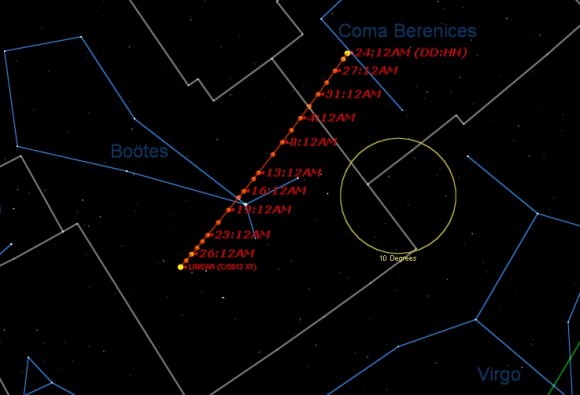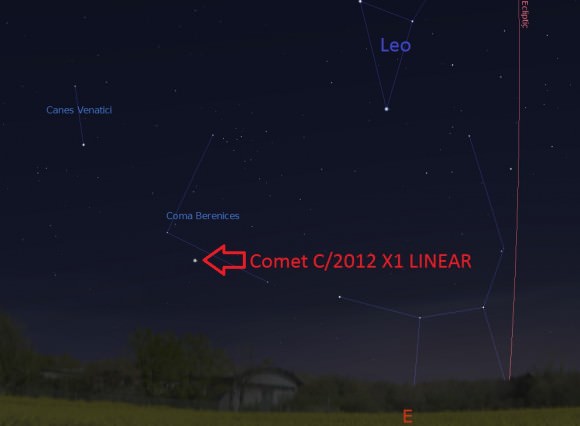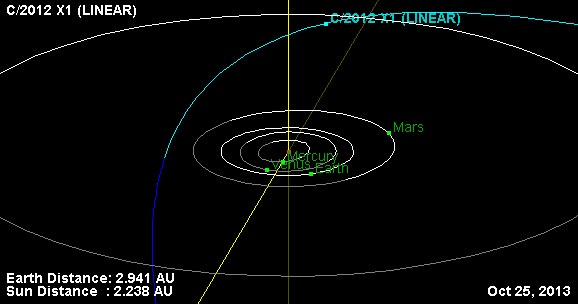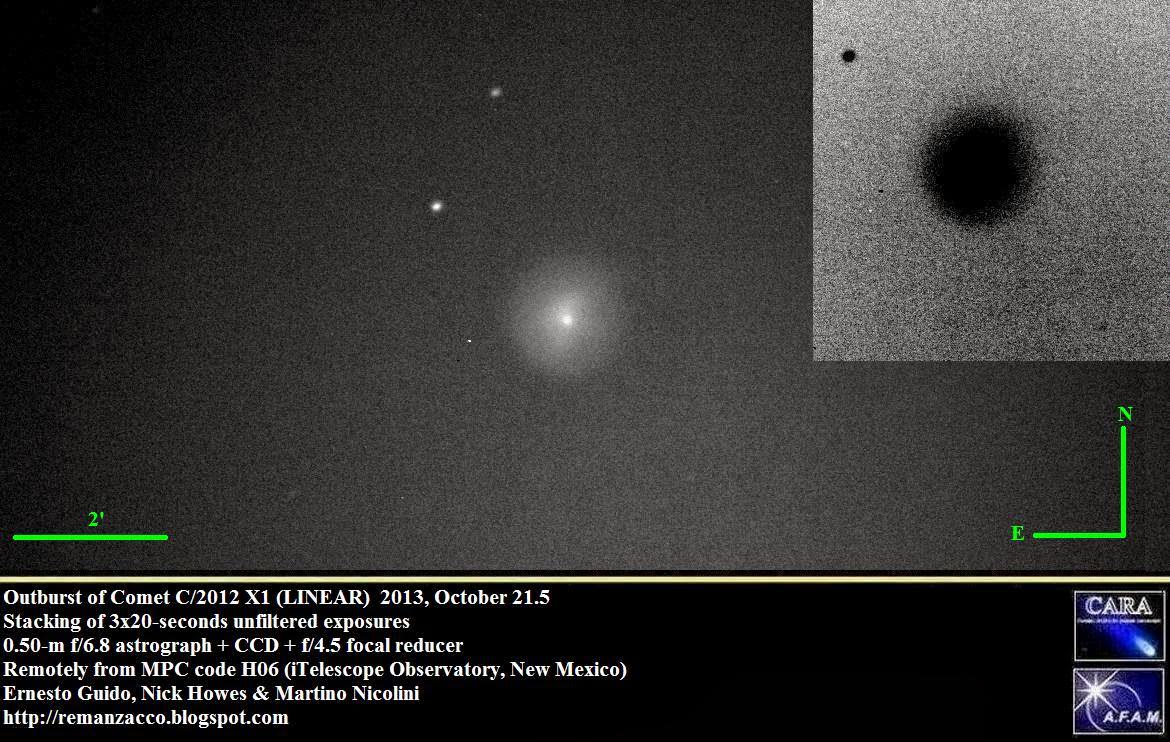It’s swiftly becoming an “all comets, all the time” sort of observing season. The cyber-ink was barely dry on our “How to Spot Comet 2P/Encke” post this past Monday when we were alerted to another comet that is currently in the midst of a bright outburst.
That comet is C/2012 X1 LINEAR. Discovered on December 8th, 2012 by the ongoing Lincoln Near Earth Asteroid Research (LINEAR) survey based in Socorro, New Mexico, Comet X1 LINEAR was expected to peak out at about +12th magnitude in early 2014.
That all changed early this week, when amateur observers began to report a swift change in brightness for the otherwise nondescript comet. Japanese observer Hidetaka Sato reported the comet at magnitude +8.5 on October 20th, a full 5.5 magnitudes above its expected brightness of +14. Remember, the magnitude scale is logarithmic, and the lower the number, the brighter the object. Also, 5 magnitudes represent an increase in brightness of 100-fold.
Astronomers Nick Howes, Martino Nicolini and Ernesto Guido used the remote 0.5 metre iTelescope based in New Mexico on the morning of Monday, October 21st to confirm the outburst. Other amateurs and professional instruments are just now getting a look at the “new and improved” Comet X1 LINEAR low in the dawn sky. Romanian amateur observer Maximilian Teodorescu noted on yesterday’s Spaceweather that the comet was not visible through his 4.5 inch refractor, though it was easy enough to image.
Comet X1 LINEAR currently sits in the constellation Coma Berenices about mid-way between the stars Diadem, (Alpha Coma Berenices) and Beta Coma Berenices. Shining at +8.5 magnitude, the coma is about 85” across with a 10” bright central region. This gives X1 LINEAR the appearance of an unresolved +8th magnitude globular cluster. In fact, a classic globular and a star party fave known as M3 lies about 8 degrees away at the junction of the constellations Canes Venatici, Boötes and Coma Berenices. M3 shines at +7th magnitude and will make a great contrast on the hunt for the comet.
Unfortunately, the window of time to search for the comet is currently short. From latitude 30 degrees north, the comet sits only 15 degrees about the northeast horizon 30 minutes before local sunrise. The situation is a bit better for observers farther to the north, and mid-November sees the comet 20 degrees above the horizon in the dawn sky.
Comet X1 LINEAR is currently covering 40’ (2/3rds of a degree, or 1 1/3 the size of a Full Moon) a day, and will spend most of the month of November in the constellation Boötes. Keep in mind, X1 LINEAR is currently still on brightening trend “with a bullet.” Revised light curves now show it on track to reach magnitude +6 near perihelion early next year, but further brightening could still be in the cards for this one. Remember Comet 17P/Holmes a few years back? That one jumped from an uber-faint +17th magnitude to a naked eye brightness of +2.8 in less than 48 hours.
Comet X1 LINEAR will reach a perihelion of 1.6 Astronomical Units (A.U.s) from the Sun on February 21st, 2014, and pass 1.6 A.U.s from the Earth around June 28th, 2014. The comet has a high inclination of 44.4° degrees relative to the ecliptic, and is on a respectable 1872 year orbit.
Here are some notable dates for the comet through the end of 2013;

-November 2nd: Crosses into the constellation Boötes.
-November 6th: Passes near the +4.9th magnitude star 6 Boötis.
-November 16th: Passes near the bright star Arcturus.
-December 6th: Crosses into the constellation Serpens Caput.
-December 10th: Passes near the +5 magnitude star Tau1 Serpentis.
-December 14th: Comet X1 LINEAR sits only 8 degrees from Comet ISON.
-December 26th: Crosses into the constellation Hercules.
Note: “Passes near” on the above list denotes a pass closer than one degree, except as noted.
Now, we REALLY need the Moon to pass Last Quarter phase this coming Saturday so we can get a good look at all of these dawn comets! As of writing this, the current scorecard of binocular comets— comets with a brightness between magnitude +6 and +10 —sits at:
-2P Encke: +7.9 magnitude in Leo.
-C/2013 R1 Lovejoy: +8.7th magnitude in Canis Minor.
-C/2013 X1 LINEAR: +8.5th magnitude in Coma Berenices.
-C/2012 S1 ISON: +9.7th magnitude in Leo.
-C/2012 V2 LINEAR: +8.9th magnitude in Centaurus.

It’s also amusing to note how the method of notification for these sorts of outbursts has changed in recent years. I first heard of the outburst of X1 LINEAR on Monday evening via Twitter. Contrast this with Comet Holmes in 2007, which came to our attention via message board RSS feed. And way back in 1983, we all read about of the close passage of Comet IRAS-Araki-Alcock… weeks after it occurred!
Another curious phenomenon may also work its way through the news cycle. When Comet Holmes became a hit back in 2007, spurious reports of comets brightening became fashionable. If you were to believe everything you read on the web, it suddenly seemed like every comet was undergoing an outburst! This sort of psychological trend towards wish fulfillment may come to pass again as interest in comet outbursts mounts.
It’s also worth noting that, contrary to rumors flying around ye’ ole web, Comet X1 LINEAR is not following Comet ISON. The two are on vastly different orbits, and only roughly lie along the same line of sight as seen from our Earthly vantage point.

And that’s it for our weekly (daily?) segment of “As the Comets Turn…” don’t forget to “fall back” one hour and plan your morning comet-hunting vigil accordingly this coming Sunday if you live in Europe-UK. North America still has until November 3rd to follow suit.
Happy comet hunting!
-Got a recent pic of Comet X1 LINEAR? be sure to post it in the Universe Today Flickr forum!

